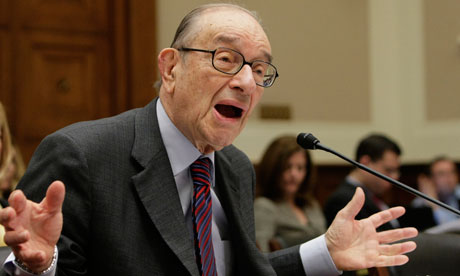 |
| Former Chairman of the US Federal Reserve, Alan Greenspan. |
Introduction:
The return of John Maynard Keynes in the wake of the most damaging financial downturn since the Great Depression has sparked a debate that challenges the legacy of the Great Moderation and the 20 years of calmness that prevailed over the vast plains of global financial markets. Indeed voices have risen from the fallout of the financial crisis that continually clammer that Friedrich Hayek, neoliberalism and free markets, that which has defined the last three decades of Western economics, is not the End of History.
The debate has entered mainstream media as epitomised by the financial lyricism of ‘Fightof the Century’ as seen above, an ideological sparring match that stages a rap battle between the two political and economic ideologues of the 20thand 21st Century. One, Friedrich Hayek the exemplar of libertarian economics, the other, John Maynard Keynes the man of the big state, government spending and interventionary economics.
Indeed prompted by the ‘Fight of the Century’ the purpose of this monograph is to consider financial markets and the changes that are necessary in order to bring decorum to a world of finance sailing over choppy ideological waters, battered by a raging gale of populist anger.
In order to do so it is necessary first to understand what in fact caused the worst financial contraction since the Great Depression. Fittingly the syllables, words, paraphrases and metaphors from henceforth will be the tools at hand as this paper starts on an archaeological dig that seeks to unearth the causes and enter the substratum of the Great Crash of 2008.
In order to do so it is necessary first to understand what in fact caused the worst financial contraction since the Great Depression. Fittingly the syllables, words, paraphrases and metaphors from henceforth will be the tools at hand as this paper starts on an archaeological dig that seeks to unearth the causes and enter the substratum of the Great Crash of 2008.
However, a crisis that was caused by a morbid mix that included a fast and loose monetary policy, a fanciful federal housing policy, widespread irrational exuberance among consumers on Main Street, rampant excess by the financial alchemists on Wall Street and recklessness among credit rating agencies, this paper wants to dig deeper, down into the cultural form of modern society and into the ideological rhetoric that has shaped modern finance.
Ultimately the goal of this paper is to navigate the tempestuous ideological currents and to consider the future of free markets and to pose an answer to the ideological uncertainty.
Part 1: The Great Credit Crash of 2008
- Chapter 1 - a classic tale of boom and bust
Innumerable jeremiads have been written, told and screened throughout academia, the popular press and the wider media telling a classic tale of boom and bust. Fittingly the following section shall attempt to capture the mood and chronicle step by step the rise and fall of the global economy.
i. A five shot deadly cocktail fuels a housing bubble
The housing bubble that started inflating in the mid 1990s and carried on until 2006, teetered in 2007 and eventually burst spectacularly on September 15th 2008. A day that witnessed ‘history in the making’ (Thain, 2009) and an event that saw a billowing real estate bubble spew its toxic financial contents across the globe. Indeed the contents were a cancerous financial contagion that spread across global capital markets in systemic and stratified waves of destruction crippling credit lines, halting inter-bank lending, freezing assets and setting the fate of the global economy on a knife edge.
However how did the lethal housing bubble form in the first place?
For over forty years house prices in the post-war period moved in tandem with the overall rate of inflation, but from the middle of the 1990s the two variables diverged and house prices took off on a steady upward trajectory in the absence of any discernible inflationary pressure. Indeed the new trend that saw housing prices outstrip the rate of inflation ensured that real estate prices in theU.S. rose by more than 70 percent between 1995 and 2007.
For over forty years house prices in the post-war period moved in tandem with the overall rate of inflation, but from the middle of the 1990s the two variables diverged and house prices took off on a steady upward trajectory in the absence of any discernible inflationary pressure. Indeed the new trend that saw housing prices outstrip the rate of inflation ensured that real estate prices in the
[To read further and see the dissertation and references in full, click here.]
No comments:
Post a Comment